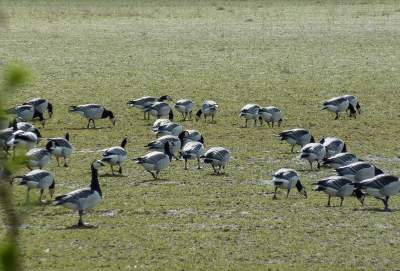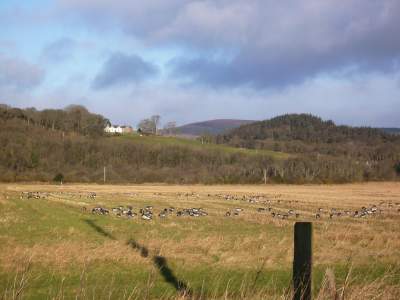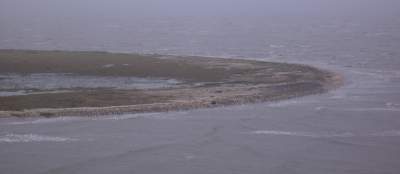
With only a week to go till Christmas, and just a few weeks to go as a Natural Communities trainee, it’s time for my last blog post, complete with reader challenge!
I have spent the last 6 weeks at the RSPB’s Mersehead reserve on the Solway coast. I’ve been doing some people engagement work in the Visitor Centre, as well as helping out with WeBS counts (Wetland Bird Survey), barnacle goose counts and a little bit of land management.
This is what I’ve learnt so far: counting birds is HARD WORK. The first couple of times I was asked to count the barnacle geese, I couldn’t get past three (seriously) before my brain shut down. This was not helpful bearing in mind they hang out at Mersehead in their thousands. You’ll be pleased to hear I have improved since these early days and actually reached 287 with confidence last week!
I have put together a short bird-counting challenge so that you too can test your counting skills under pressure. First one: How many barnacle geese can you see in this photo? 
That was an easy one to warm you up. (There are 10.) How about this one:
Another easy one to lull you into a false sense of still-being-able-to-count. (I got 36.) Here is a more difficult goose shot:
Admittedly it is easier with binoculars or a telescope. (In other words I haven’t actually counted this one.) But here is the KILLER: How many oystercatchers are at the high tide roost?
Fun hey! And this is when the birds are keeping still! (My estimate was 2,300.)
The majority of my time at Mersehead has been taken up with project work. I have been looking at conservation volunteering opportunities for deaf and hard of hearing people. The result of this was a Deaf Awareness in Conservation workshop which took place here at Mersehead a couple of weeks ago, attended by people from a number of conservation organisations in the region.
The workshop had three main aims:
- To give key figures in local conservation the opportunity to meet and learn from the experiences of a profoundly deaf man working in conservation, the manager of the Galloway Wildlife Conservation Park.
- To inspire conservation organisations to include deaf people in their public events and volunteering opportunities, as well as to organise events aimed specifically at deaf or hard of hearing groups.
- To allow participants time to consider their own sites, visitor centres and events from a deaf or hard of hearing person’s point of view, looking at ways to develop accessibility, interpretation and enjoyment for people with hearing loss.
The workshop was really interesting and was a valuable learning opportunity for everyone involved. First of all, John Denerley of the Galloway Wildlife Conservation Park told the group about his background in conservation, and went on to give his recommendations for improving accessibility for deaf people. He spoke through a British Sign Language interpreter, and for many people this was the first experience they had had of communicating in this way. It was important to get across that this is not as scary as might seem, like any unknown.
Next, Kelly Brindley of the Forestry Commission gave a short presentation about two practical projects she has run with deaf volunteers in South Yorkshire (see link for more details). Kelly was very enthusiastic about the benefits to everyone involved, including a huge amount of confidence gained by the deaf people, both in themselves and in how they felt about using the forest. She said she benefited from having a BSL interpreter with an interest in the outdoors, but apart from speaking through an interpreter, she did not do anything differently with this group compared to working with any other volunteer group. I think this was a real eye-opener for participants.
Anne Youngman of the Bat Conservation Trust had brought in bat detectors to demonstrate the way these can be used with deaf participants. The bat detectors, which convert ultrasound calls to a pitch audible to humans, produce sound which can be felt by deaf people as a vibration. The Bat Conservation Trust have produced an excellent report, the Bristol Deaf Community Case Study, which contains advice on how to engage the deaf community with bats. It is a brilliant resource, well worth reading!
Finally, we did a bit of work in small groups, focussing on barriers preventing engagement with deaf people, ideas for ways to engage with them, and planning an activity that they could carry out in their area of work. We shared our ideas at the end, with John being able to make suggestions. The ideas and observations that the groups came up with were fantastic, and I am very optimistic that the outcome of the Deaf Awareness workshop will be partnership working between deaf organisations in Dumfries & Galloway and local branches of organisations such as WWT, Forestry Commission, RSPB and Solway Firth Partnership. It’s a shame that I won’t be able to carry on the project any further myself, as I’m now out of time.
Thanks are due to the Barfil Charitable Trust for funding this workshop.
So now I’ve only got three weeks left here in Dumfries & Galloway, a place I’m still getting to know. One way or another, it’s been a busy and challenging year, and I’d like to say thanks to all the people who’ve helped me. Good luck to all the other trainees, and I hope we’ll be able to catch up soon!

